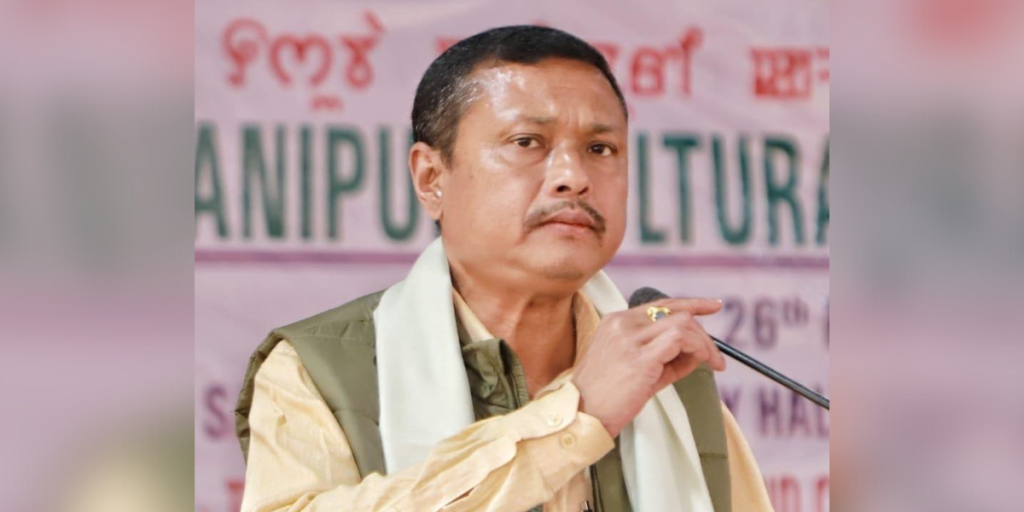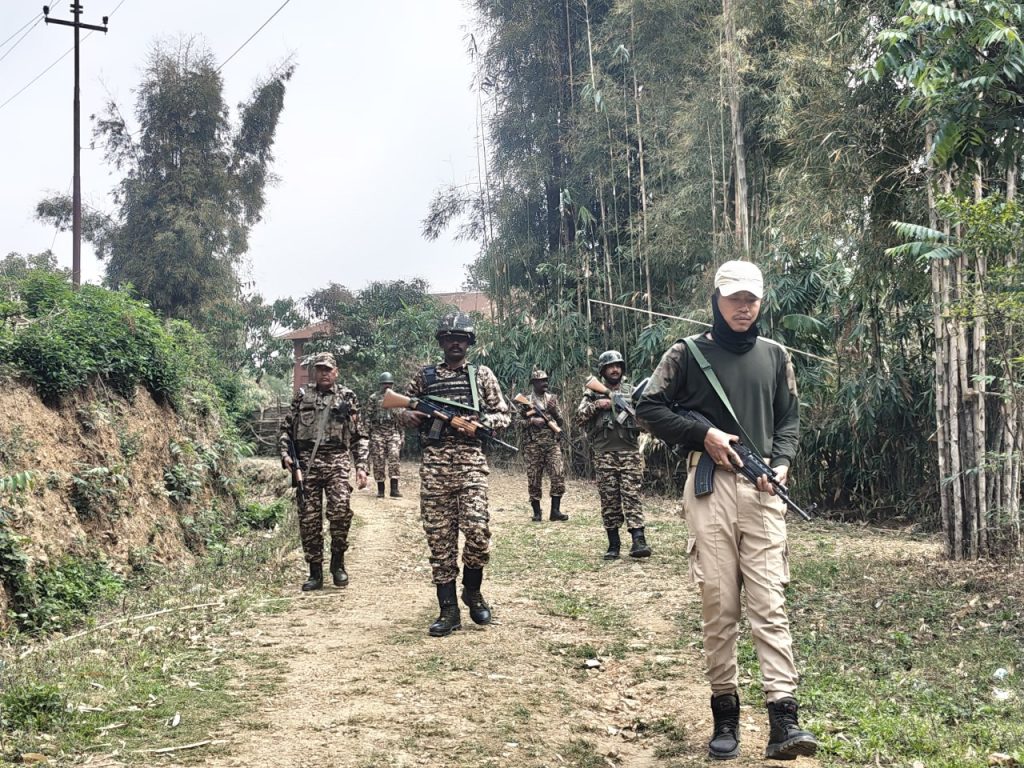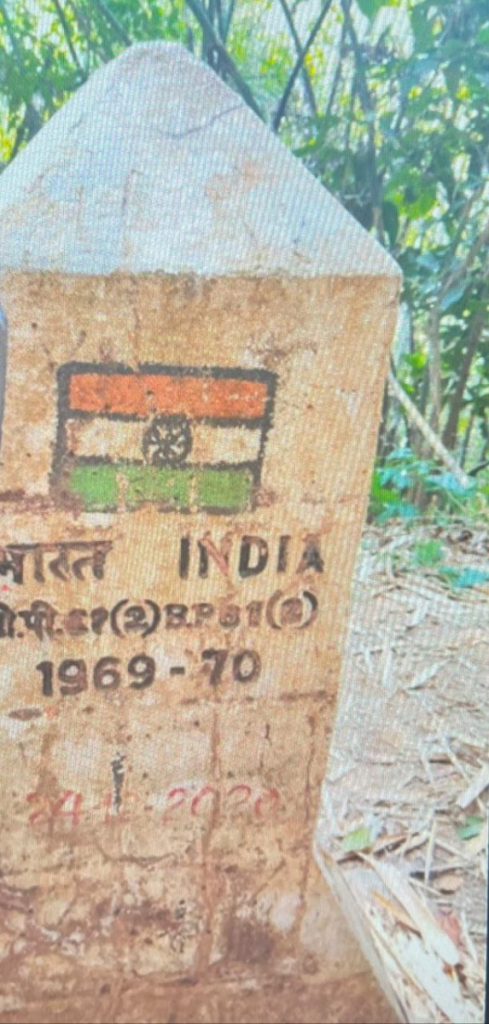How the Arambai Tenggol Has Escaped a Ban and Charges of Separatism Despite Being Armed
It was the morning of April 13, 2025. The venue was the Lamboi Khongnangkhong grounds in Imphal.
On those sprawling public grounds, you could see elegant women in their Phanek, beating their Manipuri drums while men played the region's string instrument, pena.
The day and the celebration of Cheiraoba, a traditional annual festival, is significant to the Meitei community.
The day is also celebrated across valley areas of Manipur as Athoubashingi Numit.
But to get a more significant picture of present-day Manipur, you would have to widen this frame to include two other actors present at the Lamboi Khongnangkhong grounds.
One was the Bharatiya Janata Party (BJP) Rajya Sabha MP Leishemba Sanajaoba, also the Meitei 'king', standing in front of the musicians in his traditional outfit.

Leishemba Sanajaoba. Photo via his Facebook account.
Sanajaoba was swaying his hands as if he was playing the role of the conductor of that musical commemoration. The motif on his white muffler stood out — a pair of Sangai deer, the endangered species unique to the Imphal valley, and the state animal of Manipur. The pair of deer were embroidered on his muffler in saffron, the colour of his party.
The other presence was that of multiple able-bodied youth, in black fatigues and bandanas, standing in neat rows behind the musicians; their faces marked with guerrilla-like black stripes. Throughout the performance, they stood in attention, as if waiting for a whistle to launch into action.
Those men belonged to Arambai Tenggol (AT), the armed militia founded by Leishemba Sanajaoba sometime in 2020, whose existence became known to the wider world only in May 2023 though, when it had hit the headlines for allegations of violence committed on the minority Kuki community during the ethnic violence that broke out since May 3, that year.
Sanajouba, being its chairman, had named Arambai Tenggol after the poisoned arrows once used by the army of his ancestors, the Manipuri kings, to ward off the invading Burmese from its eastern frontier.
During the 2023 violence, AT was not only accused of looting arms from Manipur Police but also of physically assaulting policemen and three Opposition Congress legislators for not taking the oath the AT had dictated to them at Kangla Fort, Sanajaoba’s ancestral residence.
On April 13 though, AT cadres led by their immediate commanders were unarmed at the grounds.
That’s because they were there to play football, a game that draws crowds not just in Manipur but in most parts of the Northeast. The occasion was the launch of an event in Imphal themed around the armed outfit – The First Arambai Tenggol Football Tournament.
In the crowd were youth wearing AT football team jersey with the insignia of a fighter on horseback armed with a bow and a poisoned arrow aimed at the invisible enemy.
What Sanajaoba, the chairman and ideologue of AT said was important. His speech was the formal articulation of not just a turning point in the long drawn out armed movement within the Meitei community of that border state, but also the launch of a new model of it, unseen in the Northeast till 2023. He said:
“Arambai Tenggol was established to defend our land, culture and identity. We are not anti-national or against anyone. Our real intention is to defend and protect Manipur and India.
“However, we were compelled to take a role that we never intended to. Some may say that Arambai Tenggol have surrendered their weapons and are living as civilians. But, at any given time, we will be ready for the call to defend our land.”
Media reports said the BJP MP further “lauded Arambai Tenggol” in that public meeting, stating that “its actions today stand as a testament to that belief and are a matter of pride.”
“While the group had assumed a different form during a critical period to protect the Meetei (Meitei) community and Manipur, it has now reverted to its foundational identity, engaging in religious practices, farming and sports…Nevertheless, Arambai Tenggol should not be mistaken for a passive or inactive group.”
A local news report said that Sanajaoba had warned, “If any threat arises against Manipur and its people, the organisation will not hesitate to return to its former role.”
The typical structure and ideology of Meitei armed outfits
What Sanajaoba formally articulated that day must be seen as nothing short of a watershed moment in the history of the insurgency and armed movement that had sprung out of Manipur’s majority community.
Thus far, as many as seven valley-based or Meitei insurgency groups are banned by the Union government, primarily for their separatist agenda. Among armed movements within various northeastern communities, the Meitei groups have stood out for being adamant about not dropping Manipur’s ‘sovereignty’ issue as a condition to enter into any peace talks with New Delhi.
Among these armed groups, the United National Liberation Front (UNLF) is the oldest; this is the 61st year of its existence. Another, the People’s Liberation Army (PLA), was born in 1978. Factional fights might have led to the birth of more insurgent groups from within the community over the decades but their ‘sovereignty’ peg had more or less remained undiluted.

In this image posted by @manipur_police via X on March 21, 2025, security personnel conduct a search operation and area domination in the fringe and vulnerable areas of hill and valley districts. Photo: X/@manipur_police via PTI Photo.
In the course of their insurgency, these groups have rarely been seen unleashing violence on sister communities of Manipur. Their focus has remained on targeting Indian security forces for obvious reasons.
In the thick of the recent ethnic conflict, though, we did see a faction of the UNLF — the Pambei group – signing a peace treaty with New Delhi. This was a curious development as Pambei, the head of the group, was missing from the formalities. Though the Union home ministry called it a ‘historic development’ in a press note and the minister Amit Shah declared the peace deal with UNLF(P) as a ‘historic milestone’ on X, the top leaders of that faction were arrested by the National Investigation Agency (NIA) after they came overground, on charges of arms training and so on, in the course of the ethnic conflict that began on May 2023.
How Arambai Tenggol changed the game
In that April 13 speech, Sanajaoba was categorical about Arambai Tenggol’s intent — “not anti-national” and "established to defend our land, culture and identity.”
He certainly drew from Hindutva vocabulary when he underlined that his armed outfit is “not anti-national”. What he likely indicated was that AT's work might be hinged on Meitei nationalism and lined with the community’s pre-Vaishnava religion Sanamahi, but it is not separatist – like the valley-based banned outfits have been. Therefore, AT is different from the regular Meitei armed groups.
He also added a novel component – that it will be a socio-religious and sports group till a conflict situation arises. In such a situation, it would reserve its right to take up arms.
This is a clever move, even though it does not address the illegality of the fact that a group will be taking up arms – something which is the purview of the state police and the central security forces.
Armed groups taking part in an ethnic conflict in the Northeast is not new but what is new is this AT model – the flexibility it has given itself to stretch from being a socio-religious group to an armed militia run by the titular head of a community while the state looks on.
UNLF’s one-time chairperson R.K. Meghan also belonged to the Manipuri royal family, and is a respected name within the community till day. Meghan chose a jail for several years over peace talks with New Delhi. In 2019, he returned to the community and was hailed as a hero. Since then has refused any political position from the BJP, unlike Sanajaoba.
Sanajaoba has drawn the legitimacy of his outfit from the fact that he is the chief resident of the Kangla Fort, the regal edifice standing in the middle of Imphal and signifying the community’s rich history. That he was picked by the party that has its government in New Delhi offers the AT a different sort of legitimacy than the retinue of Meitei armed groups batting for the community’s interests.
Unconfirmed reports from Imphal now say that several AT cadres are actually from the Meitei insurgent groups which are under a ban. Rumours are abound across the state that many such militants were “given free passage” to enter the valley areas which till recently were outside the ambit of the Armed Forces (Special Powers) Act, unlike the hill districts. If these allegations are indeed true, questions can be asked on what it would mean for Manipur's chance at peace.
Contestations around Myanmar border fencing
The name and the insignia of the AT must be given due attention too, not just for the history it carries, but also in regard to the ongoing contestations around India fencing the long Myanmar border.
The word 'Arambai' has been plucked out of a dart-like weapon that was used by Manipuri kings’ cavalry (the Tenggols) to ward off the invading Burmese army. The lethal nature of the darts was feared by the Burmese. Many in mainstream India may not be aware that the Burmese had ruled a good part of the Northeast in the early 19th century, including both Assam and Manipur. It was to chase away the Burmese that the British had first ventured into the Northeast from Bengal in the early 19th century. The significance of Arambai Tenggol cavalry can be located in frequent Burmese invasions till the British decisively took over the reins.

Border Pillar 61 near New Samtal village, Chandel district, Manipur. Photo by Special Arrangement/Karishma Hasnat.
Sanajaoba naming his outfit so must be located to the growing insecurity among a large swathe of the Meitei community since the last decade or so over alleged large-scale illegal immigration from Myanmar. The allegation is that they have blended into the Kuki community which lives close to the international border. Meiteis may be Manipur’s majority community but their number is not huge, and therefore, the fear of losing dominant position in an electoral democracy is forever looming.
An added concern is that while the tribes can buy land in the valley areas, Meiteis cannot do the same in the hill areas. The majority of Manipur’s land is hills. The shrinking opportunity to buy land is a raw sentiment. By calling his militia-cum-socio-religious outfit Arambai Tenggol, Sanajaoba is clearly hoping to play with that insecurity of his community and herald a fight that he says is to “defend our land, culture and identity”.
This position is contested by the border people across Mizoram, Manipur and Nagaland. They are opposed to India fencing the Myanmar border and scrapping the free movement regime (FMR) with the Myanmar government, citing kinship with the tribes residing on the other side of the international border.
Similarities with the Salwa Judum model
Perhaps the most significant part of this new model of an armed group springing up in the Northeast is its close affinity to the structure of the infamous Salwa Judum of Chhattisgarh.
If Sanajaoba can be credited to have founded and mobilised youth for AT, the architect of Salwa Judum in Chhattisgarh was another politician, Mahendra Karma. His elder brother Lakshman Karma was an MP too.
Though he officially belonged to the Congress, it is common knowledge in Dantewada and elsewhere that Mahendra Karma had the tacit support of both the Congress and the BJP. To be precise, he had the support of the Chhattisgarh government when it came to training the local youth and supplying them with arms to fight the Maoists.
At its launch in 2005, Karma had said, “This is the first such example where the villagers are fighting shoulder-to-shoulder with security forces in the interests of the country. This is a historic struggle because the common man supports it."
Speaking to this correspondent some time ago on record, a Meitei youth, caught by a Manipur Police team donning police uniform and moving in a police vehicle (he is now facing an NIA case) with looted arms during the 2023 ethnic conflict, spoke on similar lines, “I left home because we were told by our seniors that we are helping the police fight the Myanmarese who had come in huge numbers. We thought we were helping the police and saving our community.”
Though the anti-Maoist militia, filled with local youth, were granted support and training by the Chhattisgarh government and acted like an auxiliary force, Salwa Judum gradually became an ugly vigilante movement, remembered for committing human rights violence on fellow members of the community. Hundreds of innocent people faced atrocities at their hands, and were killed. Besides arms, the Salwa Judum volunteers also used bows and arrows. The see-saw of violence claimed Karma’s life eventually.
In 2011, the Supreme Court deemed Salwa Judum’s existence illegal, and asked the Chhattisgarh government to recover all its arms and ammunition. In May 2015, journalist Aditya Sinha had written, “Salwa Judum created more problems than it solved, and even the Supreme Court had to tell the Chhattisgarh government not to outsource the law to private hands.”
Also read: Manipur Tapes: Did Biren Singh Get Banned Militant Groups to ‘Join Together’ With the Police?
In the case of AT, arms and ammunition were also picked up from state police armoury. The Manipur Tapes case, currently being heard in the Supreme Court, is, therefore, significant. It would help establish if the state had played any role in arming the AT during the ethnic violence as a voice sounding like chief minister N. Biren Singh did claim something similar. The voice also claimed that it was bringing the state and the non-state forces together, similar to the Salwa Judum model.
Though Singh has denied that it was him in those leaked tapes, the report of a well-known private laboratory, Truth Lab, submitted by the petitioner to the apex court, had said his voice and the voice in the tape matched “93%”.
In a recent ground report from Imphal, The Wire had highlighted the control AT has now over the business establishments and residences left behind by the Kuki residents of the capital city, flouting a Supreme Court order.
After President’s Rule was announced in February 2025, governor Ajay Bhalla’s first task was to ensure recovery of the looted arms. He called for voluntary surrender of arms within a seven-day deadline which had to be extended. AT set some conditions to the governor on arms surrender at a closed door meeting. Its leaders refused to share those conditions with local media.
AT did surrender some 307 arms on the final day of the deadline but the state did not make public the list of weapons it actually surrendered.
Salwa Judum was born as a counter-insurgency force in Chhattisgarh at a time when Ajit Doval was the Intelligence Bureau chief. Doval is national security advisor now.
The ethnic conflict in Manipur since May 2023 has given voice – like never before – to the demand from the state’s majority community to fence the Myanmar border citing 'illegal immigrants’. That task was, till now, almost impossible because of the support of the border residents to the free-movement arrangement with those across the border.
Sixteen months after the ethnic conflict, in September 2024, Union home minister Amit Shah announced that the international border would be fenced at a cost of Rs 32,000 crores.
This article went live on May twenty-third, two thousand twenty five, at zero minutes past ten in the morning.The Wire is now on WhatsApp. Follow our channel for sharp analysis and opinions on the latest developments.




